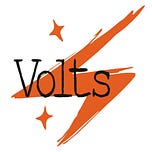In this episode, we’re diving into the wonky but vital topic of performance-based utility regulation (PBR) with Cara Goldenberg and Laura Gonzalez. We discuss how traditional utility regulation creates perverse incentives for utilities — and the tools PBR offers to better align incentives with modern priorities to like resilience, equity, and decarbonization. Dozens of states have adopted some form of PBR or other, and Virginia might be next.
(PDF transcript)
(Active transcript)
Text transcript:
David Roberts
Right then. Hello, everyone. This is Volts for October 23, 2024, "Tying utility profits to actually doing a good job." I am your host, David Roberts. As I have lamented here on Volts — and before that, at Vox, and before that, at Grist — the financial incentives of investor-owned power utilities are not well aligned with our aspirations for a climate-friendly electricity system. The regulatory structure that currently governs utilities was designed for growth and speed; utilities make more money by selling more power and making big new infrastructure investments upon which they receive a guaranteed rate of return.
Anything that reduces the amount of utility power needed — things like energy efficiency or distributed energy resources — translates into lower profits, which utilities generally don't like. Spending on anything other than new infrastructure — things like operational expenses, maintenance, compliance costs, customer service, equity and clean energy goals — is at best a secondary priority.
You can yell at utilities about this, and I have, but the only way to change it in the long term is to change the incentives. And the only way to do that is to change the regulatory structure.
Enter performance-based regulation (PBR). PBR can get complicated in practice, but the basic idea is simple: it just means that utilities should profit (or not) based on how well they perform … like every other business in a capitalist economy. There is a broad set of tools available to regulators, but in all cases the goal of PBR is to align utility incentives with modern needs like resilience, equity, customer satisfaction, or carbon intensity.
Several states have adopted some version of PBR and more states are considering it all the time, including, at this very moment, Virginia. To discuss all of this I’m thrilled to be joined by Cara Goldenberg of RMI and Laura Gonzalez of Clean Virginia. We’re going to get into why PBR is needed, what it looks like in practice, and where it might pop up next.
With no further ado, Cara Goldenberg and Laura Gonzalez, welcome to Volts. Thank you so much for coming.
Cara Goldenberg
Thank you so much for having us, David.
David Roberts
This gets real geeky, real quick.
Cara Goldenberg
It does.
David Roberts
So, I'm going to start with you, Cara. Maybe before we discuss this alternative form of regulation, this alternative regulatory structure, we should discuss what is the prevailing regulatory framework and what's wrong with it, why we feel like we need reform in the first place. So, the standard regulatory framework is called cost of service, or COS in the jargon. Maybe just start by explaining to us, what does that mean? What is cost of service regulation?
Cara Goldenberg
Yes. Okay, so, and I'll try to make this as less wonky as possible. So, a traditional cost of service regulatory model, this is where utility regulators, also known as public utility commissions, or PUCs, in a lot of states, they're responsible, right, for determining an investor-owned utility's revenue requirement. How much money are they going to be able to collect through customer rates so that the utility can recover its costs and earn a reasonable return for its shareholders? So, how this works in practice, right, is a utility files an application to raise rates.
David Roberts
This is called a rate case.
Cara Goldenberg
Exactly. The PUC opens that rate case. The PUC examines the costs the utility claims were necessary to provide safe, reliable service and excludes any costs that it deems unnecessary.
David Roberts
In the rare event that it actually does that.
Cara Goldenberg
Exactly. And so, then that is sort of how the PUC estimates the utility's cost of service, hence where the name comes from, and then sets the annual level of revenues that utilities are able to collect. And then, that is how rates are then set.
David Roberts
And it's important to point out that once that happens, the utility is just on its own. It gets that rate of return now, no matter whether it provides good service or not, or whether the customers are happy or not, or whether they're meeting state renewable energy goals or not. After that, there's basically no mechanism to regulate the utility after that. Once you've approved its costs, basically, that's it.
Cara Goldenberg
Right. You're approving what it's spending, not, you know, what outcomes actually result from that spending.
David Roberts
And that's why we call it cost of service, basically. Like, it's recovering whatever it costs them to provide the service.
Cara Goldenberg
Exactly. And as you said in the intro to this podcast, this worked quite well in the early 20th century when we were encouraging utilities to build infrastructure, expand their systems, right? Given the policy goals we have today, the technologies that are now available, there's a number of perverse incentives in this model that run counter to our priorities.
David Roberts
Also worth putting as a baseline here. Like, this was great for expanding service. It was designed for expanding service. But now, like to a few decimal points, everybody's got service, right? In the US, everybody has service. So, this incentive to grow, grow, grow and spend, spend, spend, you know, it's just sort of like a hangover.
Cara Goldenberg
And it's even more important today where we have all this load growth that's expected coming out of the system, right? We don't want to just keep on growing our system. We want to be able to efficiently grow our system to meet the new needs, right?
David Roberts
So talk a little bit about just in general, the perverse incentives that cost of service regulation creates why is this a problem now?
Cara Goldenberg
Right. So, there's a number of perverse incentives, but I'll highlight the three most prominent. Right. So, there are a couple of perverse incentives that are created by how that revenue requirement for the utility is established. And that's because, as you said, capital expenditures, also known as CapEx, and this is physical infrastructure, goes into what we call a rate base on which the utility earns a return for its investors. On the other hand, OpEx is just a pass-through to customers.
David Roberts
Operational expenditures.
Cara Goldenberg
Operational expenditures. Thank you. And so, there's no profit opportunity for OpEx. So, what do you think would happen? Right. Utilities have a bias towards those capital expenditures, and this leads to two perverse incentives called gold plating and CapEx bias. And I can get into both of those. But gold plating, it refers to when utilities are incented to deploy more CapEx than is necessary to generate more profits.
David Roberts
Well, I mean, if they literally mechanically make more money by spending more money, then in any given case of spending money, they're obviously going to want to spend as much money as possible. Like, they're obviously going to want to buy the nicest stuff possible, right?
Cara Goldenberg
Exactly. It's inherent in their business model. Right. And so, of course, they're going to propose perhaps pricier than necessary solutions, or they may not be leveraging the existing assets they have on the grid to avoid new infrastructure investments. And so, it can be really problematic, especially as we run into affordability challenges and cost increases all over the US.
David Roberts
Right. So that's gold plating. The other one, you said, is CapEx, the bias towards CapEx. And I think this is also straightforward. Like, imagine if you're a utility and you had the choice, you could either do some sort of operational maintenance things on your power line that would allow it to transmit more power, thus avoiding the need for a new power line for which you will get nothing. Right. That's all operational and maintenance costs. You don't get any profit on that. Or you can buy the new power line, which will get you your big rate of return.
Obviously, you're going to want the new power line.
Cara Goldenberg
Obviously, yeah. And so this is, you know, fundamentally baked into the regulatory construct that the utilities are operating within. Another perverse incentive we see is called the throughput incentive. And this is what encourages utilities to sell more energy instead of getting paid to deliver the right amount of energy. And so this is, as you said in the beginning, sort of the major reason why utilities might oppose energy efficiency or distributed generation, any other innovation that actually reduces energy sales.
David Roberts
Yeah, and this is something, if you've listened to Volts at all, you know I'm constantly ranting about exactly this. But, like, if you get paid more, the more energy people use, then right there, it's not complicated, right there, energy efficiency takes money out of your pocket very straightforwardly. Allowing your customers to use less energy very mechanically, takes money, profits, out of your pocket. There's no, this is not some complicated second derivative type of thing here. It's right there on the surface. Like, the more power you produce and the more people use, the more you get paid.
So, of course, you're not going to want them to use less.
Cara Goldenberg
Exactly. And I think, as you said, the objectives we have for the energy transition, the new technologies we have available to us, we can't afford sustaining this traditional model that is preventing us from really innovating in this space and taking advantage of the full solution set.
David Roberts
Yeah, and this is why, you know, as I said many times, like, every utility has energy efficiency programs, which people might think, "Well, if it's so against their interests, why do they have these programs?" Well, they have these programs because they're forced to by their PUCs. And so the PUC does, says, "Do x amount of energy efficiency," and the utility will sort of begrudgingly do x amount of energy efficiency, but it's not going to do x plus one. You know what I mean? It's not going to be thoughtful or innovative about how to go beyond and do even more efficiency because every bit of energy efficiency hurts its returns.
So, it's just like all these programs that we're forcing utilities to do, all the distributed energy programs and all these, like, sort of thoughtful, modern things are all things that utilities are going to do begrudgingly at best.
Cara Goldenberg
Exactly. I get that question a lot: "Why can't we just make utilities do these things? They are regulated by people in place to tell them what to do." But there's information asymmetry that really actually doesn't make that a possible solution. There's a huge gap in terms of what the utility knows about its system than what the regulator knows.
David Roberts
What you want, ideally, is for the utility to want energy efficiency. Right. So then, the utility is, like, looking around at its own system and thinking through how it could do energy efficiency. No outside regulatory body is going to be able to do that as thoroughly as the utility can do it.
Cara Goldenberg
Yes.
David Roberts
Okay, so this is the cost of service, the cost of service regulatory framework. And like, I have been beating this drum since, I don't know, it's more than ten years now. Just like, to me, this is the heart of our problem, the heart of our energy transition problem, because everything comes back to the grid. Everything's being electrified, everything depends on the grid rapidly evolving. And here, the entities who are most directly in charge of the grid are directly incentivized to fight all of that. It's just the most absurd situation. And most people don't even sort of know about it.
So, they're sort of like puzzled, "Why aren't utilities doing this? Why are utilities resisting this? Why are they so bad?" You know, they start thinking, "Oh, like utilities must be corrupt or evil." But no, they're just doing what they're incentivized to do. Sorry to rant, this is such a trigger thing for me.
Cara Goldenberg
Oh, I feel you. This is the focus of my work, because I agree, every issue, every challenge, you can draw it back to the utility business model.
David Roberts
Yeah, okay, so the cost of service regulatory framework is clearly not fit for purpose for modern grid needs. So then, that is what has raised the profile of performance-based regulation, which is supposed to be an alternative. So, this gets real complicated, but maybe just talk at a general level of like, what is the sort of conceptual shift here involved in PBR?
Cara Goldenberg
Yeah, so performance-based regulation is an approach that seeks to better align utility incentives with the interests of customers and society. It does this by actually compensating utilities based on their performance against targeted outcomes, rather than just basing their compensation on costs and attempts to actually remove those perverse incentives that the traditional regulatory model introduces. And it actually isn't a new approach. Performance-based regulation has been around since the early eighties, but it's been attracting more attention, as you said, due to that growing mismatch between the traditional way we've been regulating utilities and our modern policy goals.
But PBR, it's not just one thing, it's not just a single regulatory reform, but it's actually a range of regulatory tools. And so, because of this, different states and utilities can have very different PBR frameworks depending on the types of reforms that they adopt as well as the design of those reforms.
David Roberts
Right? And some, I think, are much more comprehensive than others. Some are much more stringent than others. There's a really huge range which we'll get into. So, it's a toolbox. I want to talk about some of the tools in the toolbox. I think the one that people most often think of and associate with performance-based regulation are what are called performance incentive mechanisms, or PIMs. We'll get to those in a minute. But those are sort of like the sexy top line of PBR. But there's other stuff that comes before those that I think we should talk through that are less, I think, less understood, less publicized as forms of PBR.
So, let's talk about some of those. I feel like, and correct me if I'm wrong about this, but I feel like if you're a PUC and you're contemplating this, the easiest first step is what's called decoupling. So, maybe tell us what decoupling refers to.
Cara Goldenberg
Yeah, so decoupling addresses that throughput incentive that I just explained, the utility's incentive to sell more energy to make more money. And so, revenue decoupling sort of attempts to delink sales from revenues. It does this by ensuring that the revenues utilities collect from customers are trued up to match what actually has been approved by regulators to cover their costs, no more or no less. And so, let's say the utility sells more energy one year than what was approved the next year. That would be trued up to sort of bring it back to what was authorized in the first place.
And so, the utility now knows, "I will always get that set level of allowed revenues. So, I might be less resistant to those programs like energy efficiency or DERs, any of those innovations."
David Roberts
Right. But this is an important note. Like, this removes the incentive to sell more, more, more. Right? Because you're going to get your set level of revenue. You're not going to get more if you sell more power.
Cara Goldenberg
So, your costs will be covered.
David Roberts
Right, right. Your costs will be covered. So, it removes the incentive to sell more. And maybe it reduces the resistance to these other reforms, but it does nothing to create a positive incentive to do the good things. It just removes the negative incentive, basically. You know what I mean? That's why I refer to it as kind of the lowest rung, I guess.
Cara Goldenberg
But super important, right? Yeah, sort of a no-brainer when it comes to these different tools. And even more important in the day of electrification where, yes, we do want utilities to be selling more electricity for certain use cases like electric vehicles, but we want them to do it efficiently.
David Roberts
Right. So, if they're not incentivized to sell more to make more, then they will have the same normal incentive that any business in a capitalist society has, which is to achieve its ends with the lowest possible investment. Right. Like, it's not sort of incentivized to overspend.
Cara Goldenberg
Yeah. And I think that is one of the most important objectives of PBR, is to actually incentivize cost efficiency, to make sure that utilities actually have skin in the game and can benefit from reducing their costs and delivering a more efficient system.
David Roberts
Right. So, to get there, you have to go beyond decoupling. Am I right in thinking that decoupling is the most common form of PBR that's actually, in effect?
Yeah, decoupling is quite common for both electric and gas utilities. And then I'd also say performance incentive mechanisms, specifically for energy efficiency and demand side management. So, as you said, decoupling takes away that perverse incentive. Performance incentive mechanisms then add a positive incentive for utilities to seek those savings.
We'll get to those in just one second. We've got some more boring tools to go through before we get to the exciting ones. So, the second sort of common and easiest thing is what's called multi-year rate cases. This is, I think, really interesting to describe what that means and why it's helpful.
Cara Goldenberg
Yeah, we call them usually multi-year rate plans, but yes.
David Roberts
MERPs
Cara Goldenberg
Yes, definitely the less sexy PBR tool, but honestly, in my view, the most important tool.
David Roberts
Interesting.
Cara Goldenberg
And that's because multi-year rate plans really can create strong incentives across utility spending decisions. So, how do they do this, right? Multi-year rate plans extend the time between rate cases.
David Roberts
Which are now typically yearly, I mean, is it sort of standard that they're yearly?
Cara Goldenberg
Yeah, about one to two years. Rate cases can be quite long as well. So, but yeah, they extend that time beyond two years, I'd say. And they also include a cap on how much revenues the utility can collect from customers. And that's really important because if the utility is able to find ways to reduce its costs, it can benefit financially from those savings.
David Roberts
So, if you think from the utilities' perspective here, instead of having to do this every year, every two years, say you have like a five-year time horizon, then you're not sort of saying to tweak things to meet yearly targets. You have a little bit more freedom to experiment with things that might reduce costs. You can come a little over in one year and a little under another year without freaking out about it. You just have a little bit more room to maneuver, I think, when you have more years to work with.
Cara Goldenberg
Exactly. And that's becoming quite important in terms of thinking about aligning our rate plans with our actual system plans and thinking about what the system looks like in the longer term, in five years out. Right. What are those strategic investments we need in terms of grid modernization?
David Roberts
Right. And there might be like grid modernization, things that utilities could do that might reduce their revenue in the first couple of years, but then once they get up and running, increase revenue. So again, if you have that longer window, you can sort of experiment, get a little bit more bold with those types of things.
Cara Goldenberg
Exactly. And there's a sense of predictability. The utilities understand what revenues they're going to be able to bring in three years, five years down the line. So, there's a level of certainty that the utilities can make these investment decisions under.
Laura Gonzalez
Yeah, I also like to think about multi-year rate plans as a budget, like putting the utility on a budget. And so, when you have a budget, you try to be as cost-effective as possible. So, you can create a difference between what's your budget and what are your costs.
David Roberts
Right.
Laura Gonzalez
And the interesting thing about multi-year rate plans is that it allows the utility to create that margin. And when you have other tools like savings sharing mechanisms, then the utility can share those savings between shareholders and customers. And at the end of the multi-year rate plan, if there are efficiencies that the utility has created, the regulator can decrease rates for customers. So, yeah, it's a very attractive tool, but it is also complicated to implement.
David Roberts
Yeah, that's important. There's a carrot here. Like, if you're put on a budget and you think and work efficiently and come in under your budget, you can keep some of that extra, that's extra profits. You mentioned earnings sharing. This is perhaps the most boring of these, but let's get it. So, say you come in under your budget, in your three-year or five-year rate plan, an earnings sharing system basically says you take that surplus and you split it, you give some of it back to customers and some of it to shareholders. Right? I mean, that's basically —
Cara Goldenberg
Yeah, they can be structured in different ways, but it basically is saying, you know, your return on equity, there's a return on equity that you're authorized in a rate case. And then if your actual return on equity is sort of far different than what's authorized, some of those earnings then can be shared with customers. And so there are earnings sharing mechanisms that share savings. If, you know, the return on equity goes beyond, far beyond what is authorized. And then there are some that actually act as more of a safeguard. So if the utility's return on equity drops far below what is authorized, there is this safeguard as well, which has become an important tool for those states that are looking at PBR in a very comprehensive way.
David Roberts
Right. So, that might be one area where the utility, if it falls short, actually has to cough up some money. So, there's a stick there too, right? Right. In addition to the carrot, I want to return to the issue of sticks versus carrots later. Okay, so those are all the boring forms of PBR.
Cara Goldenberg
The important ones.
David Roberts
Boring but important. Boring but extremely important versions of PBR were decoupling, multi-year rate plans, and earnings sharing. Those are all kind of just structural ways of changing. Oh, and the one other thing I wanted to say about multi-year rate plans, Cara, which we forgot to mention, is another advantage of them is savings on the regulatory side. Like it is, it's very costly in time and money and manpower to do a rate case. So just doing them less often saves a lot of time, money, and agita.
Cara Goldenberg
Right. For regulators, for utilities, also for other stakeholders in the process. But I want to note that it does take a lot of thought in creating well-designed multi-year rate plans.
David Roberts
It's more regulatory work upfront to get the savings over time.
Cara Goldenberg
It should be because, you know, they can be designed in very different ways. And we have seen some states not necessarily develop multi-year rate plans with customer benefits in mind. And so, it's extremely important that the regulatory process is structured in such a way that enables every, you know, different stakeholders that are interested to sort of have a say, have a seat at the table, and really understand what the utilities are putting down.
David Roberts
Well, maybe let's stay on this for one second and just talk about the possible downside here, because I know that one of the things people warn about sometimes with multi-year rate cases is you can end up with these just sort of being extra money for utilities and no one else really gets anything out of it. So, just say quickly, like, how can it go wrong?
Cara Goldenberg
Right. So, this budget that Laura brought up, setting that revenue cap, that is controversial in terms of what level of revenues is reasonable. So, sometimes those are, for example, based on cost forecasts, and those cost forecasts can be inflated. So, that's one risk that we see. Sometimes in states, there are a number of other mechanisms where utilities can recover costs outside of the multi-year rate plan, and thus they sort of layer on top of each other, and the utility is able to get cost recovery through a number of different venues, and thus, you know, those sort of pile up in terms of the ratepayer impact.
Laura Gonzalez
Yeah, and I understand that cost trackers are a very important issue to pay attention to because utilities and state regulatory models are moving towards allowing a lot of cost trackers, and in Virginia, they're called rate adjustment clauses and cost trackers are essentially the opposite of a budget. So with a cost tracker, the utilities can go to the regulator every year and say, "This is how much I spent. Can you please update the rates to recover this specific cost?" So there's not a budget concept there. It's just an update of expenditures every year.
David Roberts
Yeah, and, you know, like, I see why utilities would like that, would prefer that. I mean, it's just like, you just have to step back and be like, "What other business you just like, invest money and then you sit back and like, light your cigar and get your guaranteed returns?" All you have to do to get more money is go to the PUC and say, "What are you going to do? We had to spend more money, raise our rates." It's just like, so far from competitive. It's so far from what people think of as a market. I just have to marvel.
Okay, so we've been through the boring kinds of PBR, but important kinds of PBR. Let's talk about then, performance incentive mechanisms, PIMs, which are, I think, to the extent anyone outside our little circles knows what PBR is at all, this is, I think, what people sort of think of when they think of PBR. So, what is a performance incentive mechanism?
Cara Goldenberg
Yeah, so PIMs live in a broader family of PBR tools called performance mechanisms. And performance mechanisms, in general, are quite flexible and can really be targeted at a wide variety of regulatory objectives. So, these tools include metrics, which are actual specific, quantifiable measures used to assess a utility's performance in achieving a particular outcome. These metrics can be used to measure reliability, DER interconnection time, energy efficiency savings, right. This is how performance is actually measured.
David Roberts
Yeah. In some sense, those are kind of the easy ones, the ones where you have a number, right, that you can all sort of agree you're targeting.
Cara Goldenberg
Right. And then, scorecards are metrics paired with a target. So, these can help anchor that data, actually provide some context for that data, and can support with its interpretation. Metrics and scorecards on their own are performance mechanisms. Performance incentive mechanisms then combine the metric, target, and financial incentive.
David Roberts
Right. So, you get paid more, basically, if you do better on the metric.
Cara Goldenberg
Well, they can be structured in different ways. They can be rewards, they can actually be penalties, or they can be both: have an upside and a downside. And it really depends on the objective of the PIM. A penalty might be more appropriate if you're holding the utility accountable to a certain standard of service.
David Roberts
Right.
Cara Goldenberg
And then, you know, an upside incentive may be more effective if you're encouraging the utility to do something different or new where they don't currently have an inherent incentive.
Laura Gonzalez
I would like to highlight the importance of performance metrics and scorecards because, you know, we all are very excited about penalizing the utilities for doing something wrong or rewarding them if they're doing something nice.
David Roberts
Guilty as charged. I love penalizing utilities.
Laura Gonzalez
Yeah. But, going through the process, I appreciate the idea of just measuring things.
Cara Goldenberg
Yes.
Laura Gonzalez
That's something very, very simple that unfortunately is not done. So, for example, there are a lot of investments in grid modernization, but we don't measure how much improvement this specific investment is going to bring to the grid. We don't measure those things. We just invest and pay. But there is not an actual accountability of how those investments are working. And where did we start, where are we going, and where are we in that path? So, I think metrics and scorecards are important beyond the eagerness of penalizing and rewarding for performance.
David Roberts
It's good just to have that information out there, available. I mean, again, it's insane that like, what other business doesn't have any, like, doesn't have public results that it has to measure itself against? So just, yeah, so just measuring sort of like, let's have a metric for reliability that we all agree on, that we can all see. Even if you don't have a financial incentive around it, there's going to be some weight just to having that number public.
Cara Goldenberg
Yeah, we sometimes call it a reputation incentive. Right. And it really also helps with that information asymmetry issue that we talked about at the beginning, actually bringing to light how utilities are doing and providing quality service to customers.
David Roberts
We mentioned a few, but I want to try to give a sense of the range of metrics that you might target with one of these things. So, you said reliability, just like uptime. That's pretty straightforward, but there's a million different ones. So, what are some of the kind of metrics that states have chosen when they're doing these?
Cara Goldenberg
So, there's a range of regulatory outcomes that states can focus on that include more traditional utility responsibilities like customer service, right? But more emergent areas that we're seeing new metrics around are things like peak demand reduction, DER interconnection times, which is a big problem in a number of states, actually. How are utilities utilizing the DERs on their system, right? They also can track more policy goals. Like greenhouse gas emission reductions, beneficial electrification, objectives related to social equity, like energy burdens, disconnections. So, they can cover a sort of wide range of utility operations, services, and investments.
David Roberts
Yeah, and I think people can see, I think it's pretty intuitively clear that some of these newer ones are kind of at once the most exciting, sort of like the most intriguing, like DER connections, things like that, or equity, things that are relatively new. But also, those can be devilish to agree. Just what is that metric? Like, what are we measuring? The more you read about this stuff, it gets real complicated how to all come to an agreement on that.
Cara Goldenberg
Yes, these processes can be long. They can be complicated. It's once again really important how the regulatory process is structured. It's important that other stakeholders are able to propose ideas rather than just respond to utility proposals. But thinking about how to measure this data, what is available or what could be made available with particular investments, and what information and trends over time can be most important for understanding how utilities are actually making decisions. How are they actually performing and serving the public?
David Roberts
This has been going on in some form or another for several decades now, sort of ramping up recently. But I would hope, I would want to believe that with enough PUCs going through this process, that it's going to get easier over time, that there are like learnings that eventually, like, the next PUC that comes at it is going to have something like a blueprint available or something at least like a menu. Like, is it getting easier?
Cara Goldenberg
You know, every state has its own challenges and priorities, but we are starting to see a similar process be undertaken in different regulatory processes. So, Hawaii, for example, had a process where the goals, objectives, and desired regulatory outcomes of the PBR framework were established in the beginning with utilities, with other stakeholders, and those were then used as guideposts for the rest of the regulatory process. A regulatory sort of evaluation then took place to understand how the current regulatory framework was actually doing compared to those goals and priorities, and then determining, "Okay, where are the gaps? What mechanisms do we need to introduce?"
And so, we saw that process in Hawaii.
David Roberts
Hawaii is — sorry to interrupt, but — Hawaii is kind of the strongest, I guess you would say, like the most aggressive, the most thorough PBR reform of any state. Is that accurate?
Cara Goldenberg
In the US, yes, I would say that Hawaii has the most comprehensive PBR framework in terms of incentivizing cost efficiency, really addressing the incentives with CapEx and OpEx. Also, they have a portfolio of performance mechanisms.
David Roberts
Yeah, and a website, a public website where you can track utility performance against those mechanisms.
Cara Goldenberg
Exactly.
David Roberts
Quite clever.
Cara Goldenberg
Yes, and a lot of effort went into creating that dashboard. I recommend your audience to check it out.
David Roberts
So, I think I read somewhere that 30 states have some form of PBR or other. My guess is I can't claim comprehensive knowledge, but I'm going to guess that most of those states are doing relatively low-lift PBR stuff like decoupling. Is that accurate? How many of these 30 states are really getting into the PIMs, getting into the nuts and bolts of specific metrics and things like that? Give us a sense of really who's going for it.
Cara Goldenberg
Yes, you're right. Most of those 30 states likely have one or two of these PBR tools in place. But beyond Hawaii, Illinois now has a pretty robust PBR framework. New York does, Minnesota, states in the northeast, like Massachusetts, Rhode Island, Connecticut is, you know, undertaking a process right now.
David Roberts
Yes, we had Marissa Gillett, the head of the Connecticut PUC, on Volts last year to discuss this. The utilities are not going cooperatively into that good night, let's just say, in Connecticut. And this is another question I had, like in Connecticut, the utilities are just fighting this, fighting her, et cetera. I'm wondering, in the other states, does this tend to be contentious with utilities, or does it just vary state to state?
Cara Goldenberg
It definitely varies state by state. But, I mean, think about it, right? You have been working under a regulatory framework that has really served you well for a long time. So, there definitely is pushback. But, I do think there are actually a number of utilities right now who see the writing on the wall, who see, "Oh, yeah, DERs are going to likely play a big role in our energy transition. This actually makes sense for me for what I want to invest in. And actually, I could benefit from some of these reforms."
David Roberts
Right. Like, if you're going to have to make investments to deal with DERs, which I think all utilities are eventually going to have to because they're coming whether you want them or not. Why not figure out a system whereby you can get paid? Where you can make more money for doing that.
Cara Goldenberg
Exactly. There really could be situations where it's a win-win-win. Right? Where the utility is, you know, financially stable and able to provide reliable, affordable service. Customers are paying just what they need to, right? And are getting the programs that they need and are being supported.
David Roberts
And utilities might actually be paying attention to whether customers are satisfied and happy or not.
Cara Goldenberg
Exactly.
David Roberts
This is a novel new thing for utilities.
Cara Goldenberg
And then, also thinking about our policy objectives. Right. Actually aligning those incentives with some of the goals around greenhouse gas emission reductions, and equity and affordability. Really important.
David Roberts
So, Laura, we went through all this preamble, but let's talk a little bit about what's happening in Virginia. Who's proposing what and who's for it and who's against it?
Laura Gonzalez
Yes. So, I think everybody is for a system that is win-win-win. So that's the first thing. And then the second thing is that, as many states in the country, Virginia has experienced different forms of reforms that are similar to PBR tools. And most recently, last year, a group of stakeholders and bipartisan legislators were interested in initiating a study process. And so the goal of the study process is to explore all these tools we're talking about. And the study is supposed to start with an analysis of how does the system currently work and how these tools can improve those, evil or not evil, but those —?
David Roberts
Malign, let's say malign.
Laura Gonzalez
Yeah, those incentives that are not as conducive for the needs that we have been talking about.
David Roberts
These studies, like, you guys sent me one from Michigan. Michigan did a pretty comprehensive study like this. I can't help but think that, at a certain point, does every state have to replicate this extensive study? It seems like at some point you —
Cara Goldenberg
Got to bring people along, David.
David Roberts
Yeah, yeah, yeah.
Cara Goldenberg
And this is one step in the process, but Laura.
Laura Gonzalez
Yeah, exactly. And you know, we, in these studies, the objective is to analyze the particular situation of the state and bring along stakeholders that are, you know, local. So that's why these study processes are very important and it also is helpful to build internal expertise. So, internal expertise amongst stakeholders and internal expertise at the state corporation commission level. So, if you have a year-long study process, we all are going to learn together what are the right things we need to put in place to have an effective multi-year rate plan. How do we create a decoupling system that is beneficial for all stakeholders, etc.?
The importance of a study process.
David Roberts
Just a common vocabulary. Are utilities on board? Are they more or less on board with this process, or is there any pushback?
Laura Gonzalez
I would say they are more or less on board. Yes, they are interested in the idea and we are looking forward to starting the study process. It has not started yet, so I would say they are not opposing it.
David Roberts
Interesting. This brings me to a question I had, which I guess I would throw to both of you. Maybe, Cara, you can go first, which is a cynic might look at this and go, "It seems like most of what's happening in practice is bonuses for utilities that do a little extra, or like processes that allow utilities to make a little extra. Mostly carrots." Like, mostly what I see when I look out at the landscape of what is actually happening, I see a bunch of carrots, which is fine. Like, carrots are incentives. Like utilities will act to get their carrots, but where are the sticks?
Like, is anyone deploying real sticks? Like, is there any case where any utility has actually been denied some substantial chunk of their profits because they fell short on performance? Like, is there... How big a role are sticks playing here generally?
Cara Goldenberg
Yeah, I mean, in terms of performance incentive mechanisms and penalties that may be used, I'd say no, there hasn't been a state that's adopted a truly significant penalty that hurts utilities' profits. Right. I think the sticks, though, can come in different forms. Right. So when you think about, for example, that multi-year rate plan, where are you setting that budget? How is that budget changing year to year? It may not be a stick directly, but it's a limitation.
David Roberts
A constraint.
Cara Goldenberg
It's a constraint, thank you, exactly. You really need to think about the full picture of what the various incentives the utilities are facing. Where is that push and pull? Where do carrots make the most sense? And where do constraints and sticks also make sense?
David Roberts
So you couldn't think of an example of a utility that's been hit by a stick?
Cara Goldenberg
I mean, they definitely have been hit by sticks, right? Reliability is definitely the area where there are most penalties because that's quite important. And so, there have been penalties levied. I don't know if they are as big as perhaps you're envisioning they could be.
David Roberts
I'm envisioning big sticks, but no one else is.
Cara Goldenberg
They're not the trunk of the tree.
David Roberts
Yeah, yeah.
Laura Gonzalez
In general, yeah. This movement towards performance-based regulation is progressively implementing more sticks. You know, like in the North Carolina performance-based regulation docket, the regulator established some penalties around reliability. Hawaii also has some performance incentive mechanisms that are penalty-based for interruptions caused by generation problems. Illinois also has some performance incentive mechanisms that contemplate both penalties and rewards for the number of days it takes to interconnect distributed generation. So we are, you know, regulators are being more and more brave to contemplate specific sticks.
David Roberts
Yeah, well, I guess my other question is, because, you know, when I was thinking about the Connecticut example, so the PUC is proposing these performance-based regulations. The utilities are freaking out and what utilities are saying and what they're — there's this whole sort of class of "analysts," utility analysts, which as far as I can tell are just like lackeys of the utilities. But a lot of utility analysts are saying, "If you impose this on us, we will invest less in your state. Basically, we will cut back our investments and then you won't get any of the good things you want."
And so, you know, this is what they're sort of using to bully the PUC, just this threat, you know, because they are investor-owned utilities. They require, they rely on investor money, investor investment. And they're just saying, like, "If you put us in this regulatory structure, we'll just withdraw investment and invest elsewhere." And that will, of course, hurt all Connecticut ratepayers, will hurt the whole Connecticut electricity system. So this seems like, to me, infuriating, but also like it looks like utilities kind of have the last laugh here. Like they have the trump card because they're private entities, because they're investors they can just say, "If we don't like what you're doing, we'll invest less." How is the PUC supposed to respond to that? I don't know if I'm expecting you to solve this problem, Cara, but I'm curious about your thoughts.
Cara Goldenberg
Yeah, it's tough. It is a threat that has been used before, though, the fact that investors are going to seek to invest elsewhere. Right. I don't know how real of a threat it is. My team is trying to explore that question further and really understand if this is something that could happen. Right. But I do think that analysts look at the regulatory environment and make observations. And so, it is important for any regulator, when they're undertaking a process like this, to be clear that they want utilities to succeed in such a way that they want utilities to be able to provide reliable and affordable service.
Right. And reforms should not compromise that. But there is an opportunity to think about new models to really change the way utilities are doing business that doesn't affect their financial health, but also can bring a number of benefits to customers and to society at large.
David Roberts
Yeah, it's still irritating.
Cara Goldenberg
It is irritating. I'm not saying it's not irritating.
David Roberts
Well, it actually leads to my final question, actually, second to final question, which I wanted to get in before we get past this. Laura, maybe you can talk about this, but this is a pretty complicated and obscure, let's say, topic. It's a lot of acronyms involved, a lot of complicated processes. If activists want to get involved somehow and push this, because I do think that, like, beneath all the complication, this is one of the most important and efficacious things that can happen. Just getting utilities out of the way, just getting them to stop fighting all this stuff is one of the most important things you could do.
So if activists want to support these efforts, where do they go? Like, who do they lobby? Or how do they, how does an activist get involved if they want to?
Laura Gonzalez
Yeah, there are a couple of ways. So, the first mechanism will be to engage in these types of proceedings in front of the regulator.
David Roberts
In the PUC meetings.
Laura Gonzalez
Yeah, in the PUC meetings. Also, you know, there are other processes that happen outside of the regulatory body, like study processes. So, it is important for people to show up. It is important for people to learn what this is. And they could also submit comments in all of these proceedings. And it's also important to educate legislators and the people that represent people in the General Assembly about the core problem. Maybe it's not about being an expert on the specifics of PBR tools, but being able to articulate the general problem and the core problem is that those incentives that we've been talking about and how— you know, pressure decision makers about solving this critical issue that is holding everybody back.
David Roberts
I think that's such an excellent point. Like, you don't need to know the details of PBR mechanisms to be able to articulate why the current structure is all kinds of screwed up, why the current structure pressures utilities not to do the things we want them to do. And that's pretty simple. And I'm not sure that, like the general public, I'm not sure that politicians are really aware of that. So, just making more noise about the basic problem does seem like an excellent route. So, final question, which is speculative, so answer however you want, but I feel like I can imagine a person listening to all this and thinking, what's going on here?
Is a public body going through just contortions and building all these Rube Goldberg mechanisms, trying to beg and plead and incentivize and nudge these private entities into doing what's good for the public? It seems like it would be simpler if utilities were just owned by the public and we didn't have private utilities, and therefore, we didn't have to beg, borrow, and plead and rig elaborate mechanisms to induce these private actors to serve the public good. The public could just own the utilities, and then the utilities could just do what's in the public good, and we wouldn't have all of this bureaucratic sort of like frou frou for, you know, trying to work our way towards public goals. So, Cara, does working on this ever just make you think, like, "Why are we doing all this? Why don't we just make the utilities public entities?" You know, I mean, maybe that's not exactly on the table, but —
Cara Goldenberg
You know, PBR is one option, right?
David Roberts
Right.
Cara Goldenberg
As you say, the current model is problematic. I don't know if performance-based regulation is the right solution for every utility, investor-owned utility in every state. The reforms that are best fit for a particular jurisdiction can look very different. In one jurisdiction, that might be, you know, municipalizing, but that's also a very complicated process.
David Roberts
Yes. Just ask Boulder.
Cara Goldenberg
Just ask Boulder, exactly. And so, you know, what I try to articulate is PBR is right now a promising approach. It is a different way of working that deserves attention. It deserves exploration. But there are a lot of other regulatory reforms that are also needed to really comprehensively change how utilities make decisions. And that, I think, every state, it's going to look different. And it really does start with our articulating what is wrong in the current model. What do you want to achieve? And then exploring the different pathways to get there.
David Roberts
Yeah, I mean, just about anything is better than the dismal status quo, I think.
Laura Gonzalez
David, and I would say that to answer that question, your previous question is very important, right? Why do legislators not know about this huge problem that the system is currently creating, right? So, if legislators were more conscious about it, there would be a more clear message to the utilities. Right? Like, you have to do things right. Otherwise, you could be at peril.
David Roberts
Yeah, just making everyone more aware. You know, like you said, with the metrics and scorecards and all of this, all of this has just been buried out of public view for so long. I mean, I can imagine utilities are sort of like, from their perspective, they've spent, whatever, 100 years: You just throw money in and the money comes pouring back out and you just sit at your desk with your feet up. And then all of a sudden, I guess from their point of view, all of a sudden everybody's up in their business, wants to know how they're doing things, wants them to change things.
I can imagine it's a frenzy inside utility world. Well, this is super, super educational, you guys. I cannot thank you enough. I've been meaning to do a pod on PBR for ages, but it's kind of a thicket. But I think you were very helpful walking us through this. So, thank you to both for your time.
Laura Gonzalez
Thank you, David.
Cara Goldenberg
Thank you. It's been a pleasure to talk with you today.
David Roberts
Thank you for listening to Volts. It takes a village to make this podcast work. Shout out, especially, to my super producer, Kyle McDonald, who makes me and my guests sound smart every week. And it is all supported entirely by listeners like you. So, if you value conversations like this, please consider joining our community of paid subscribers at volts.wtf. Or, leaving a nice review, or telling a friend about Volts. Or all three. Thanks so much, and I'll see you next time.















Share this post